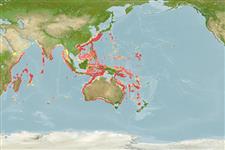Élasmobranches (requins et raies) (sharks and rays) >
Squaliformes (Sleeper and dogfish sharks) >
Centrophoridae (Gulper sharks)
Etymology: Centrophorus: centr[um] (L.), prickle or sharp point; phorus, from phoreus (Gr.), bearer or carrier, referring to grooved spines on dorsal fins (See ETYFish); moluccensis: -ensis, Latin suffix denoting place: Moluccas Islands, Indonesia, type locality (See ETYFish).
More on author: Bleeker.
Environment: milieu / climate zone / depth range / distribution range
Écologie
marin bathydémersal; profondeur 125 - 823 m (Ref. 247). Deep-water; 32°N - 40°S, 34°E - 171°E (Ref. 54313)
Indian Ocean: southern Mozambique and off Natal, South Africa (Ref. 5578); India (Ref. 31367). Western Pacific: Japan (Okinawa), Indonesia (Ambon), Philippines (Ref. 31367), Australia, New Hebrides, and New Caledonia.
Length at first maturity / Taille / Poids / Âge
Maturity: Lm ?, range 80 - ? cm
Max length : 100.0 cm TL mâle / non sexé; (Ref. 6871); poids max. publié: 2.4 kg (Ref. 40637)
Épines dorsales (Total) : 2; Épines anales: 0. A small, slender gulper shark with a long, narrow snout, a short-based 1st dorsal fin and a very small 2nd dorsal fin; pectoral rear tips elongated; denticles small and flat (Ref. 5578). Grayish brown dorsally, paler ventrally; fin of juveniles dark, with pale edges (Ref. 6577).
Found on the outer continental shelves and upper slopes, on or near the bottom (Ref. 247). Feeds on bony fish, as well as other dogfish sharks, squid, octopus, shrimp, and tunicates (Ref. 247). Ovoviviparous (Ref. 50449). Utilized as fishmeal (Ref. 31367), for its meat, fins (low value) and liver oil (very high value) (Ref.58048).
Ovoviviparous, embryos feed solely on yolk (Ref. 50449). Number of young 2 per litter; size at birth about 31 to 37 cm (Ref. 247); born at 35 cm TL (Ref.58048). Distinct pairing with embrace (Ref. 205).
Compagno, L.J.V., 1984. FAO Species Catalogue. Vol. 4. Sharks of the world. An annotated and illustrated catalogue of shark species known to date. Part 1 - Hexanchiformes to Lamniformes. FAO Fish. Synop. 125(4/1):1-249. Rome, FAO. (Ref. 247)
Statut dans la liste rouge de l'IUCN (Ref. 130435: Version 2024-1)
Menace pour l'homme
Harmless
Utilisations par l'homme
Pêcheries: intérêt commercial mineur
Outils
Articles particuliers
Télécharger en XML
Sources Internet
Estimates based on models
Preferred temperature (Ref.
123201): 9.3 - 18.5, mean 12.9 °C (based on 246 cells).
Phylogenetic diversity index (Ref.
82804): PD
50 = 0.5001 [Uniqueness, from 0.5 = low to 2.0 = high].
Bayesian length-weight: a=0.00389 (0.00180 - 0.00842), b=3.12 (2.94 - 3.30), in cm total length, based on all LWR estimates for this body shape (Ref.
93245).
Niveau trophique (Ref.
69278): 4.3 ±0.70 se; based on food items.
Résilience (Ref.
120179): Très faible, temps minimum de doublement de population supérieur à 14 ans (Fec=2).
Fishing Vulnerability (Ref.
59153): High vulnerability (60 of 100).
Nutrients (Ref.
124155): Calcium = 7.21 [1.39, 38.02] mg/100g; Iron = 0.313 [0.073, 1.003] mg/100g; Protein = 19.8 [17.5, 22.0] %; Omega3 = 0.287 [0.103, 0.899] g/100g; Selenium = 14.4 [4.6, 42.6] μg/100g; VitaminA = 13.6 [2.9, 63.5] μg/100g; Zinc = 0.29 [0.14, 0.56] mg/100g (wet weight);
